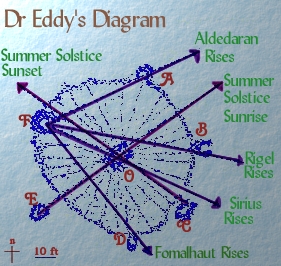Stanford has a web page. There one learns that:
n 1974, an archaeoastronomer named Jack Eddy visited this Medicine Wheel and studied its alignments, that is, its arrangements of rocks, cairns, and spokes. He found the arrangements point to the rising and setting places of the Sun at summer solstice, as well as the rising places of Aldebaran in Taurus, Rigel in Orion, and Sirius in Canis Major -- all bright, important stars associated with the Solstice. Later another astronomer, Jack Robinson, found a cairn pair that marked the bright star Fomalhaut's rising point with the Sun 28 days before solstice.
and
The dawn or heliacal rising of a star is important because it pinpoints a date exactly. This is the day a star is first seen, just before dawn, after it has been behind the Sun for an entire season. From about 1200 AD to 1700 AD, these 4 stars would have acted as solstice markers for the Native Americans - Fomalhaut (F to D) would rise 28 days before the Summer Solstice, Aldebaran (F to A) would rise during the 2 days just before the solstice, Rigel (F to B) would rise 28 days after the solstice, and Sirius (F to C) 28 days after that, at the end of August and hence marking the end of summer and time to leave the mountain.
Which sounds quite complicated and interesting, but the diagram associated with it is not so promising

The cairns aren't exactly neat geometric points, and the resolution doesn't look much better than 5 degrees. And the cairn orientations don't seem to line up with their putative use as observation points. If Jack started with a list of stars significant to the Cheyenne and found things that lined up with each of them, I'd be OK with describing it as a rough-and-ready calendar--though not 100% convinced. If he got a list of stars that were "pointed at" and then went looking for which were significant, I'd be less convinced. "look elsewhere effect"
(*) Things that don't involve strenuous hikes, and preferably also no precipices.
No comments:
Post a Comment